________________________________________________________________________________
Contents
How are the TVmap ratings calculated?
How do I use the Schedule Optimiser to track actuals versus targets on a manual buy?
How do I use the Schedule Optimiser to specify a Duration Split?
Can I run a buy against initial rates?
How do I replicate the same buy across multiple weeks?
How do I estimate ratings when the source programme is not the same as the one coming up?
Why can't Averaged R&F be calculated for selected source weeks?
How to predict ratings for Special Event Programming?
Peak and Off-Peak are not allocating TARPs correctly?
Can discounts be changed on multiple spots across multiple channels?
How can I increase the size of the Programme Schedule screen?
How to filter programmes in the Schedule Optimiser
How can I work out what my Buy would have cost had I brought against the initial ratecard?
How to break down a Buy by duration?
How can I add the actual date to my spot list in Buying?
How can I resend spots to Warner Bros. Discovery or TVNZ?
How can I break down my R&F week by week?
How do I analyse regional TARPs in Buying?
What is the difference in demographic Sample and Potential sizes when running Reach & Frequency?
How do I modify the cost of a Programme?
What can the middle mouse button be used for in TVmap?
How to calculate incremental reach of a campaign using Buying
How to Index Two Separate Demographics Using Programme List
How can I see the 30sec Equivalent Ratings?
Why do the R&F 000s/TARPs differ from those in the Summary Box of Buying?
How can I quickly see what 1+ Reach I can achieve with a selected week and channel combination?
What's happening behind the scenes when users enter their Guaranteed Audience parameters?
Why does the Buy Summary show a difference to the Guaranteed Audience line item(s)?
_______________________________________________________________________________
How are the TVmap ratings calculated in Buying?
The TVmap ratings prediction for the chosen demographic and target programme is based on actual ratings taken from the selected source weeks which are then averaged as well as the analysis of historical viewer behaviour.
TVmap then seasonally adjusts the ratings with a ‘Forecast Factor’ to account for seasonal fluctuations in viewership using PUT information for the selected timeslots.
The Forecast Factor used in the seasonal adjustment is derived from PUTs from the last seven years ratings comparing source weeks with target weeks for the selected timeslot to find out the seasonal adjustment for average viewing levels. This allows TVmap to automatically correct for the changes in viewing associated with the changes in Daylight savings.
The Forecast Factor adjustment is capped between 0.8 and 1.2 providing for a 40% adjustment range.
The predicted rating calculation including the seasonal adjustment is shown in the source week history within the buying module.
So in the example below for 1 News AT 6PM, TVmap is predicting a rating of 14.6 for the programme. This is based on the average for the last four weeks of 16.9 which has been seasonally adjusted down by 13% for November versus July in this timeslot giving a predicted rating of 14.6.
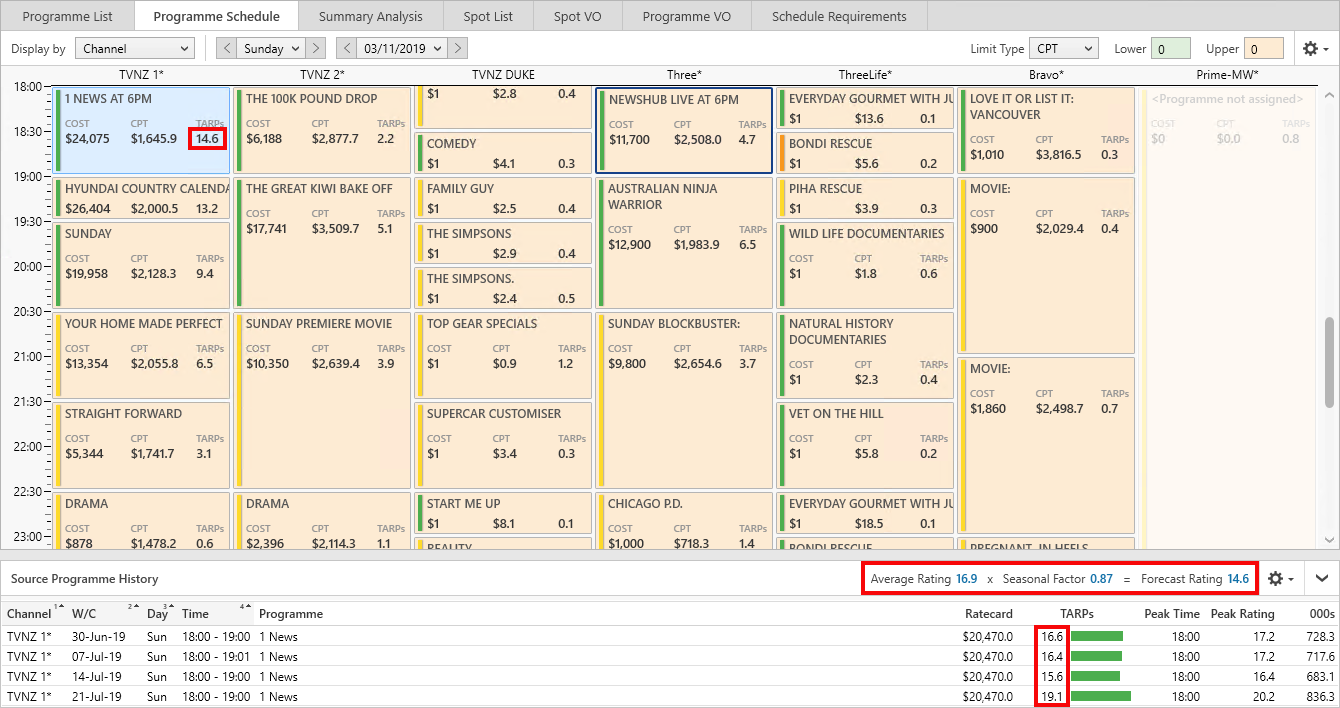
R&F ratings are based solely on the quarter hour and average of the Time Periods the spot has been run against in R&F and do not take into account seasonal adjustment.
How do I use the Schedule Optimiser to track actuals versus targets on a manual buy?
How do I estimate ratings when the source programme is not the same as the one coming up?
Can I run a buy against initial rates?
You can run a buy and select the Use initial rates options to see what a buy would have cost had it been bought at opening, rather than at some later period.
This can be useful in explaining to a client why they should buy earlier.
![]()
NB: this doesn’t highlight the reduced availability which results from buying after the opening period.
The impact of creating a buy using Initial Ratecard rates is:
•the inability to send an electronic booking (“Electronic booking is disabled while using initial rates”)
This is by design and to prevent users accidently creating and sending buys after the initial ratecard period
•the inability to save a buy using initial rates (“Saving is disabled while using initial rates”)
Again by design as selecting initial rates is designed for comparison purposes.
i.e. to give you a chance to view what your buy would have been like had it been booked when the initial rates came out
To avoid any of the above issues with using initial rates, we suggest to create buys with the “Use Initial Rates” unchecked.
This will mean you are using the latest ratecard available at the time of booking. During the buying “laydown” period this will be the initial rates but you do not need to stipulate “Use Initial Rates”.
Note: When a buy is reopened, existing spots retain the rate they have been booked with. New spots will be booked using the latest programme rates.
How do I replicate the same buy across multiple weeks?
How do I estimate ratings when the source programme is not the same as the one coming up?
Why can't Averaged R&F be calculated for selected source weeks?
When running a Reach and Frequency this message may come up
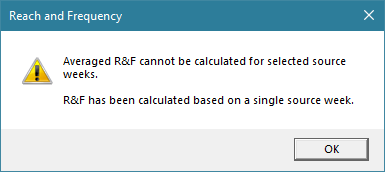
This indicates there's a change in the channel definition across the selected time periods. As a result. it's not possible to combine R&F for those selected time periods, so only one of the time periods is used. An example of a change in definition is ThreeLife becoming a plus one station.
To combine across multiple time periods to get the average R&F, choose time periods which are either before or after the change in channel definition.
To confirm dates for channel changes contact Broadcast M.A.P Support.
How to predict ratings for Special Event Programming?
Special Event Programmes can have very different ratings from previous weeks or same time last year, so using these source weeks to predict ratings may not give the best result. This is especially true for programmes like the Olympics or annual and seasonal events.
We provide indicators to show when the source weeks are varying, but these might be consistent in the leadup to a special event so will not provide a warning. Looking at the same or similar shows in the past should give a good indication of how it’s likely to perform in the future. This can be done using Find Other Screenings which is available by right clicking on any programme.
In this example let's look at 1 News Vote 2020 Election Night, it’s showing a predicted rating of 3.8 using the All 05+ demo.
Looking at the Source Programme History the programme that played over the last four weeks is different and has an average rating of 3.6
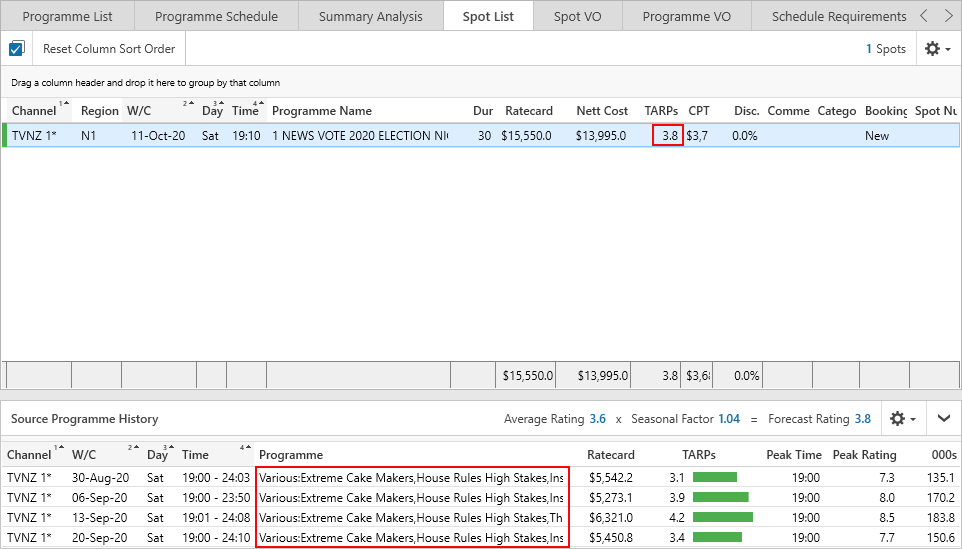
To find out how 1 News Vote 2020 Election Night rated last time it was on we can use the Find Other Screenings option
Right mouse click on the programme and select Find Other Screenings.
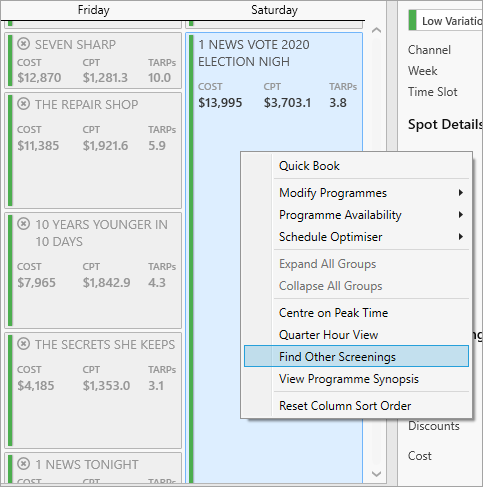
This will open the Programme Search window and we can search for previous screenings. In this case 1 News Vote 2020 hasn’t aired previously but we could use the 1 News Vote from the previous elections.
Note: The name of the previous screening may differ so use a shorter search string to find more matches. i.e. 1 News Vote. Also by default Find Other screenings will search in the last year so you may need to adjust the starting date back a few years to pick up other screenings for things like the Olympics which air every four years.
Last time it aired it got a rating of 10.8, so the upcoming screening will most likely be the same.
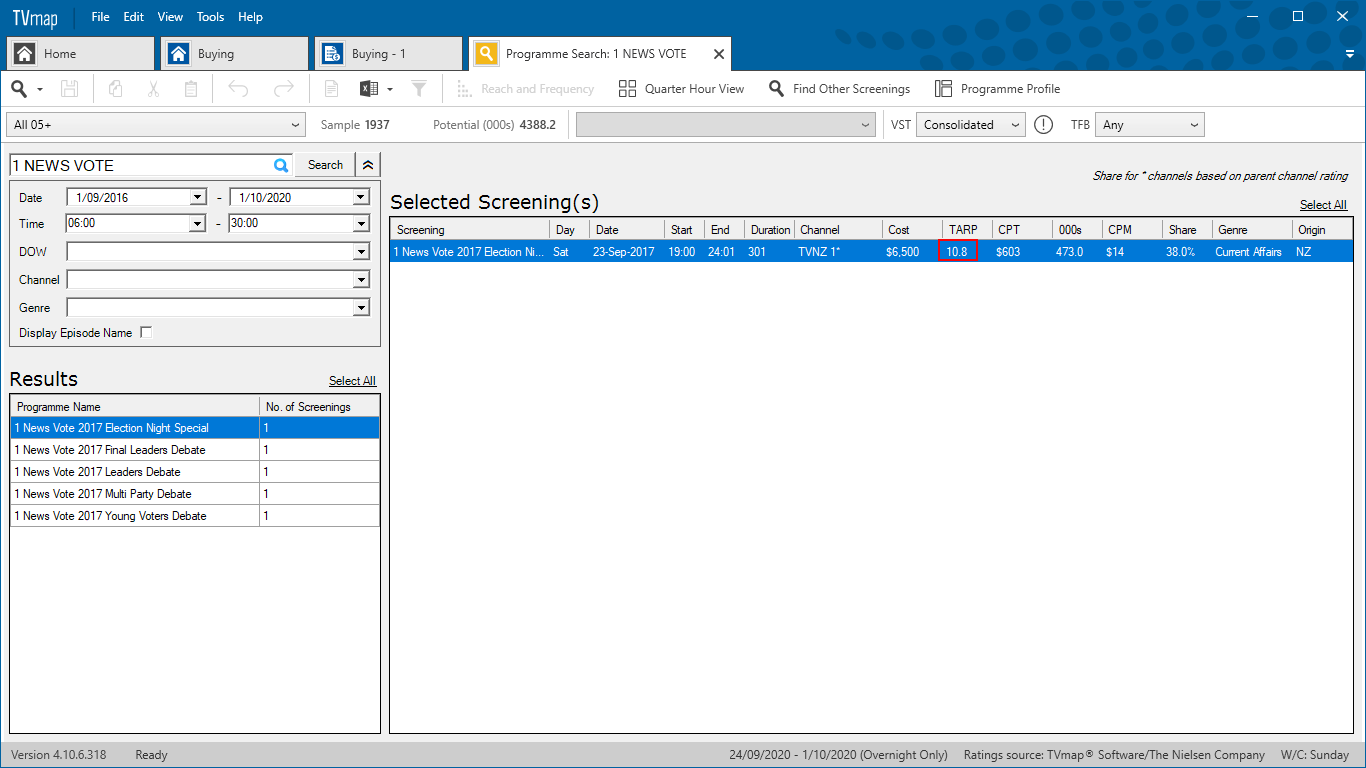
Back in the buy double click on the rating which will open the field so it can be modified

For this example we'll modify the rating to 10. Click anywhere on the screen to save the changes.

Peak and Off-Peak are not allocating TARPS correctly?
The shows themselves are treated as Peak or Off-Peak, not the individual spots.
This means there are overlaps in spot times where they are sitting in a "Peak" time programme but not in the technical definition of Peak time.
Can discounts be changed on multiple spots across multiple channels?
Yes - spot discounts can be modified for multiple spots and across multiple channels.
For spots that have already been booked
Select the spot(s) that you want to set the discount on. In this example we have forgotten to set the default discount for the buy, so we need to update the existing spots.
We can then set the default discount, so new spots have the correct discount.
Hint - Using Ctrl-A in the spot list will select all spots in one hit or click on the ![]() icon in the top left corner.
icon in the top left corner.
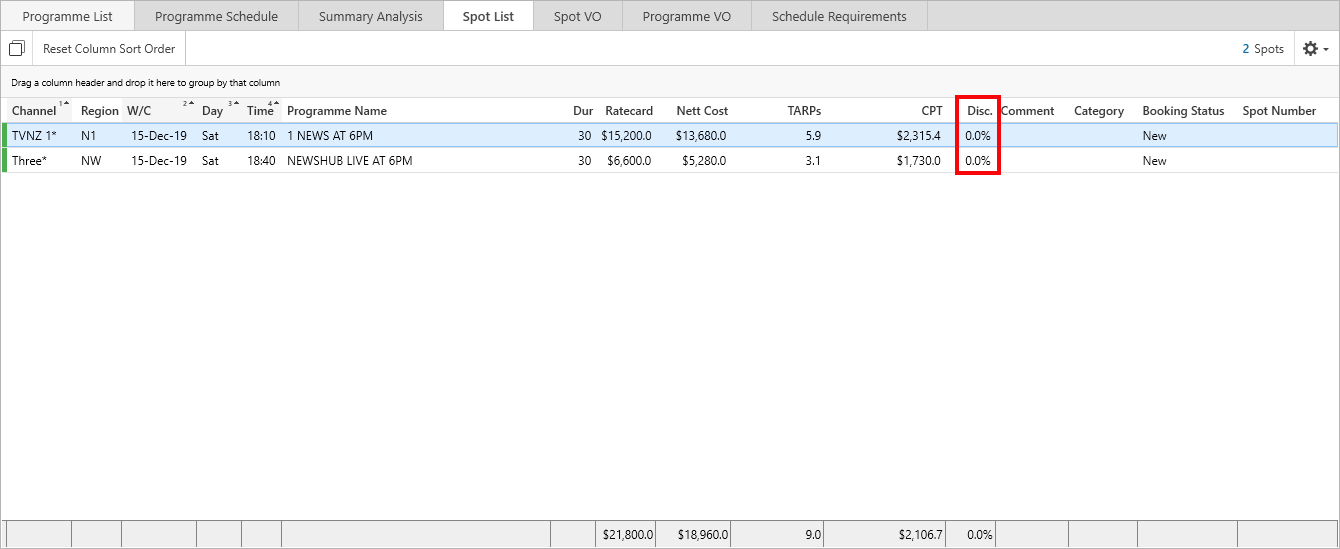
Select both spots and under Discounts in the Spot Details pane enter a discount - in this example it's 50%
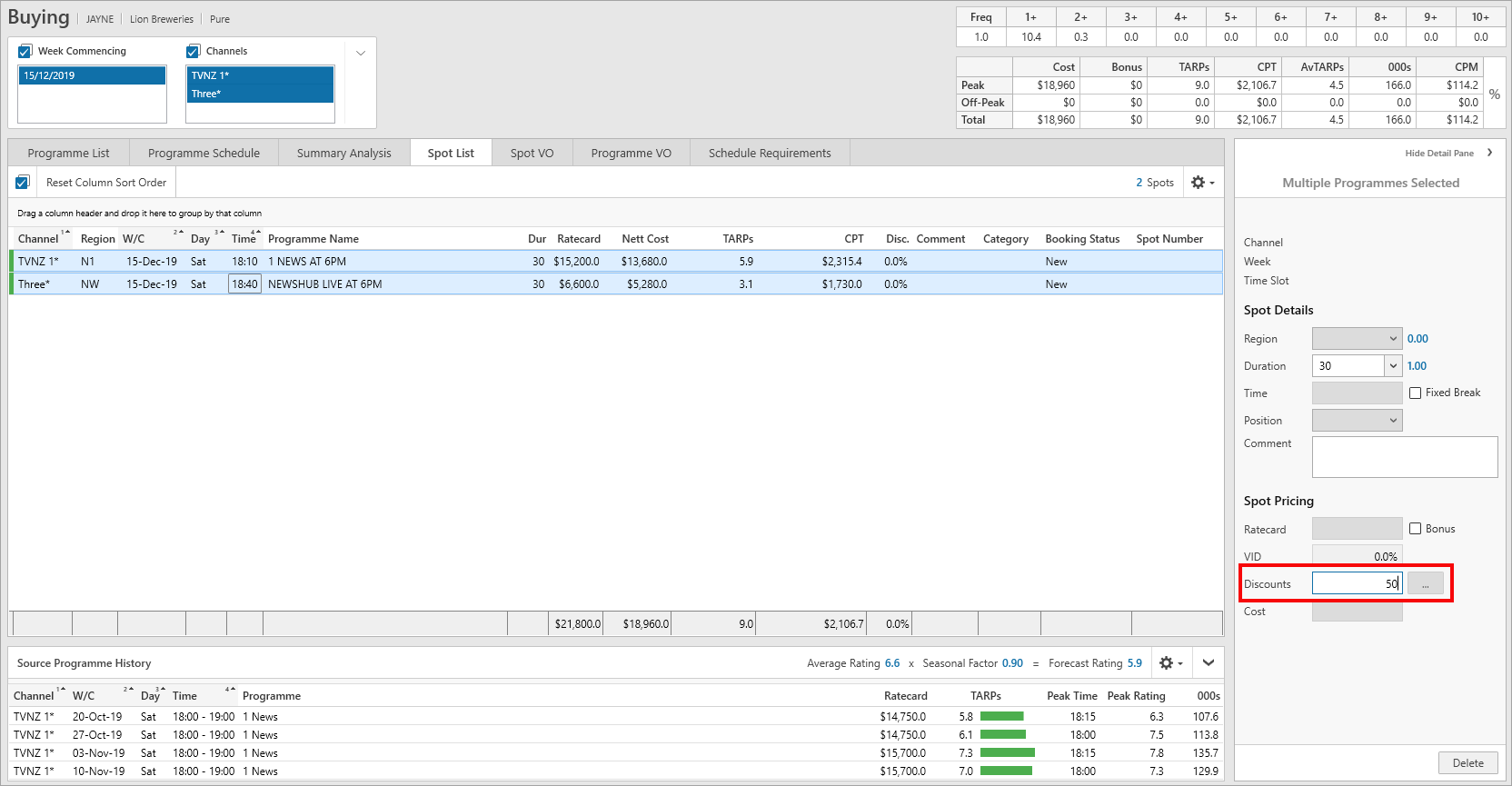
Click anywhere on the screen
It will now show a discount of 50% against both spots
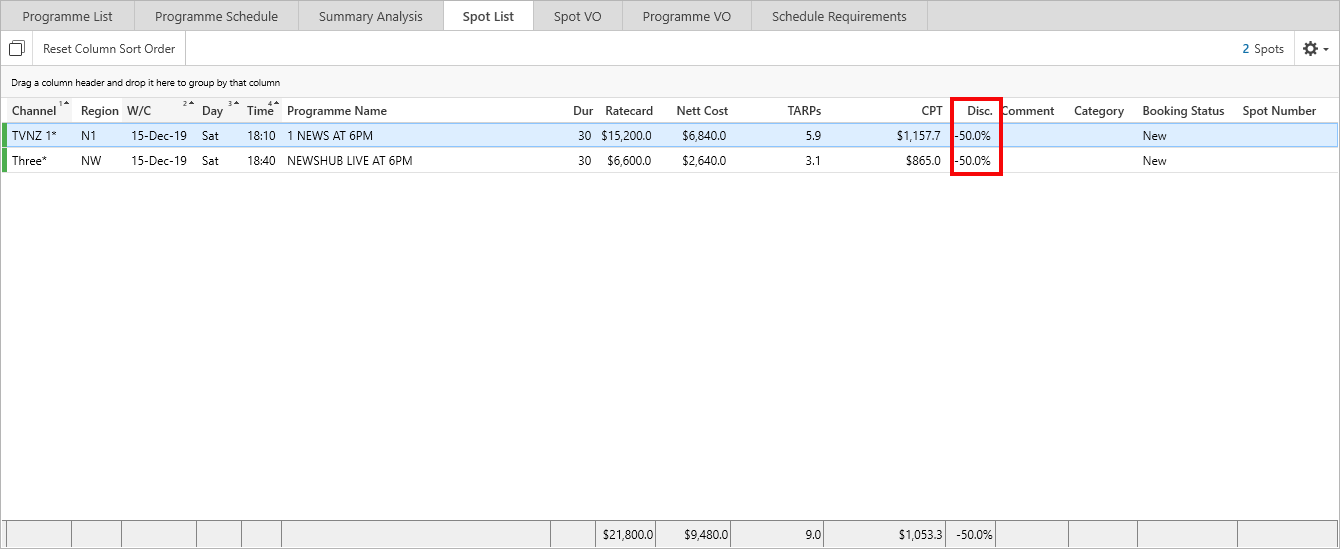
To update the default discount for the buy so that future spots are booked with the correct discount, go to the default settings for the buy.
Further details are available here Buy Discount and Default Settings
To apply a non-default discount at time of booking
To set the discount to a different value from the buy default at the time of buying.
Select the programme(s) to book into and update the discount in the Spot Details pane.
Enter the required discount - in this example it's 50%. If you want to bonus the spots you can either enter a 100% discount or there is a bonus checkbox which can be ticked and this will set the discount to 100%.
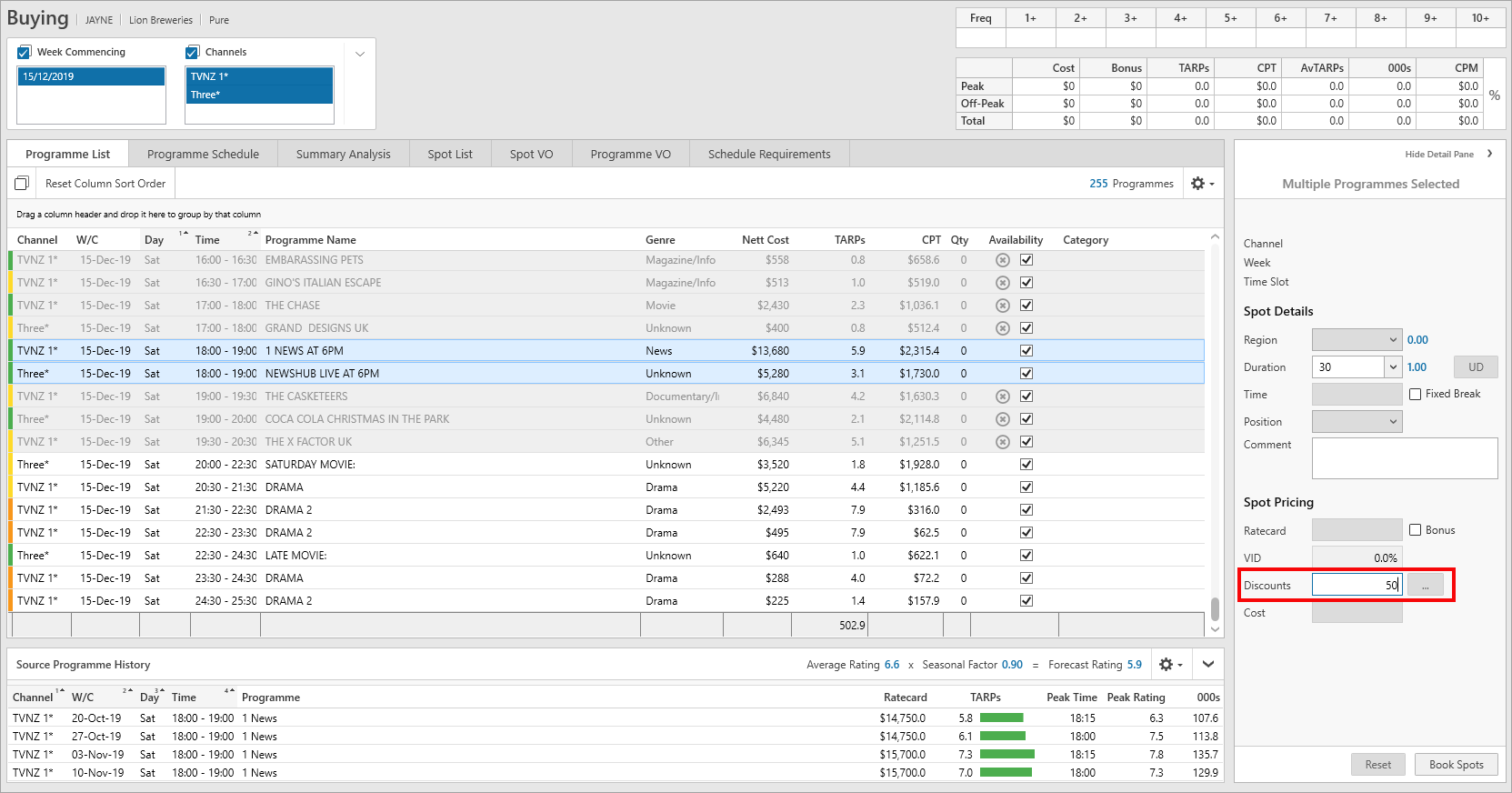
Click on the Book Spots button to book the spots.
Under the Spot List you can see the spots have the discount of 50%

How to filter programmes in the Schedule Optimiser
To exclude specific programmes from Schedule Optimiser add the Programme Name requirement under Add Spot Requirement on the Document tab
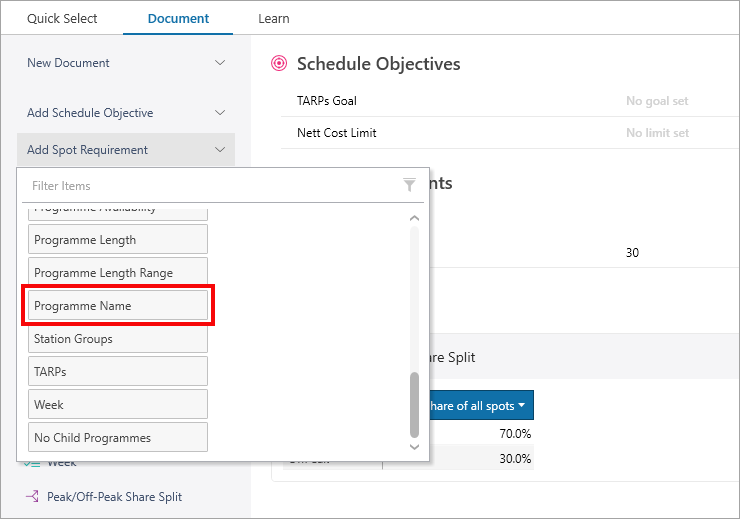
From the drop down select what option to use to filter Programme Name by
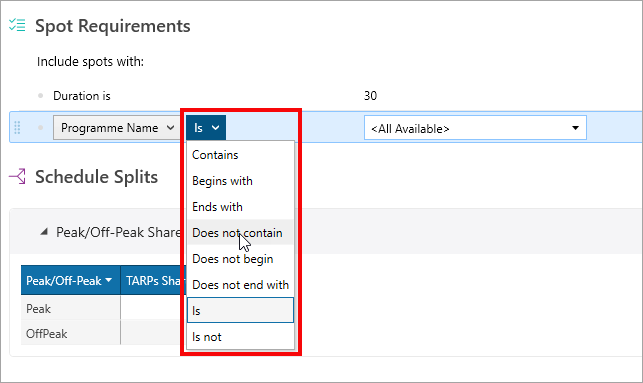
For example select 'Does not contain' and enter part of or all of the programme name

How can I work out what my Buy would have cost had I brought against the initial ratecard?
Open your buy, then open a second buy with initial rates selected.
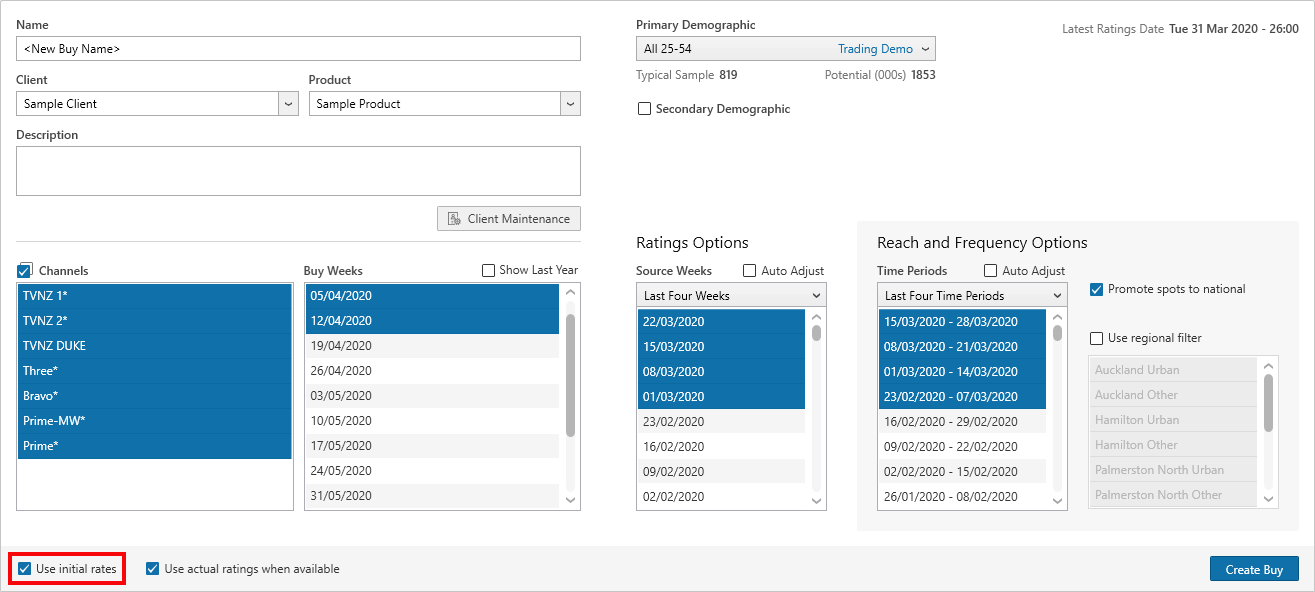
Copy the spots from your buy into the second buy you opened (with initial rates).
When pasting the spots choose to paste as new.
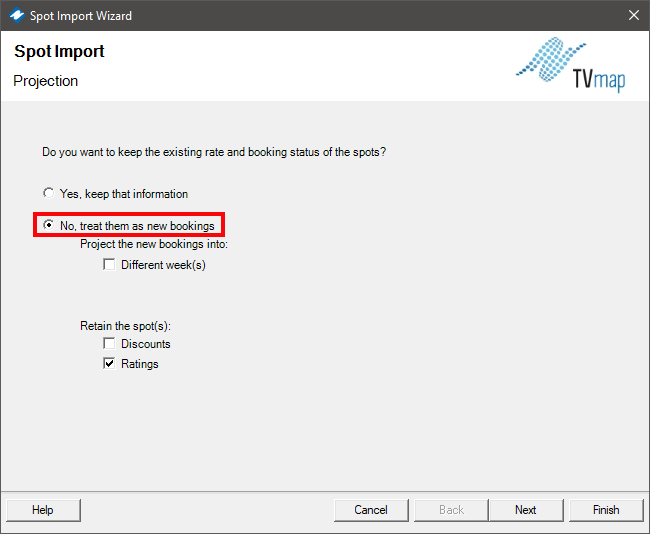
The second buy should now display the initial rates in Nett Cost column - if there has been no change between latest and initial this will remain the same.
How to break down a Buy by duration
There are three ways to break down a buy by duration
1. You can use the Summary Analysis tab
2. You can use the Group by option in the Spot List
3. You can use the Schedule Requirements Splits
Breaking down a Buy by duration using the Schedule Requirement Splits
To get more details use the Schedule Requirements tab and add a Schedule Split. Start by making sure you have Current Results:ON.
Use the example below as a guide. Here we have clicked the box on the far left to add a new split and chosen the "Peak/Off Peak" template. Then click as indicated by the far right box and change it from "Peak/Off Peak" to "Duration".
To add a different column or another column like cost share rather than TARP share click where the lowest most arrow is and you can add a nett cost share. From here you can tick the TARPs Goal/Nett Cost Limit to see columns with these values broken down by duration.
Duration options can be adjusted based where you see the top red box.
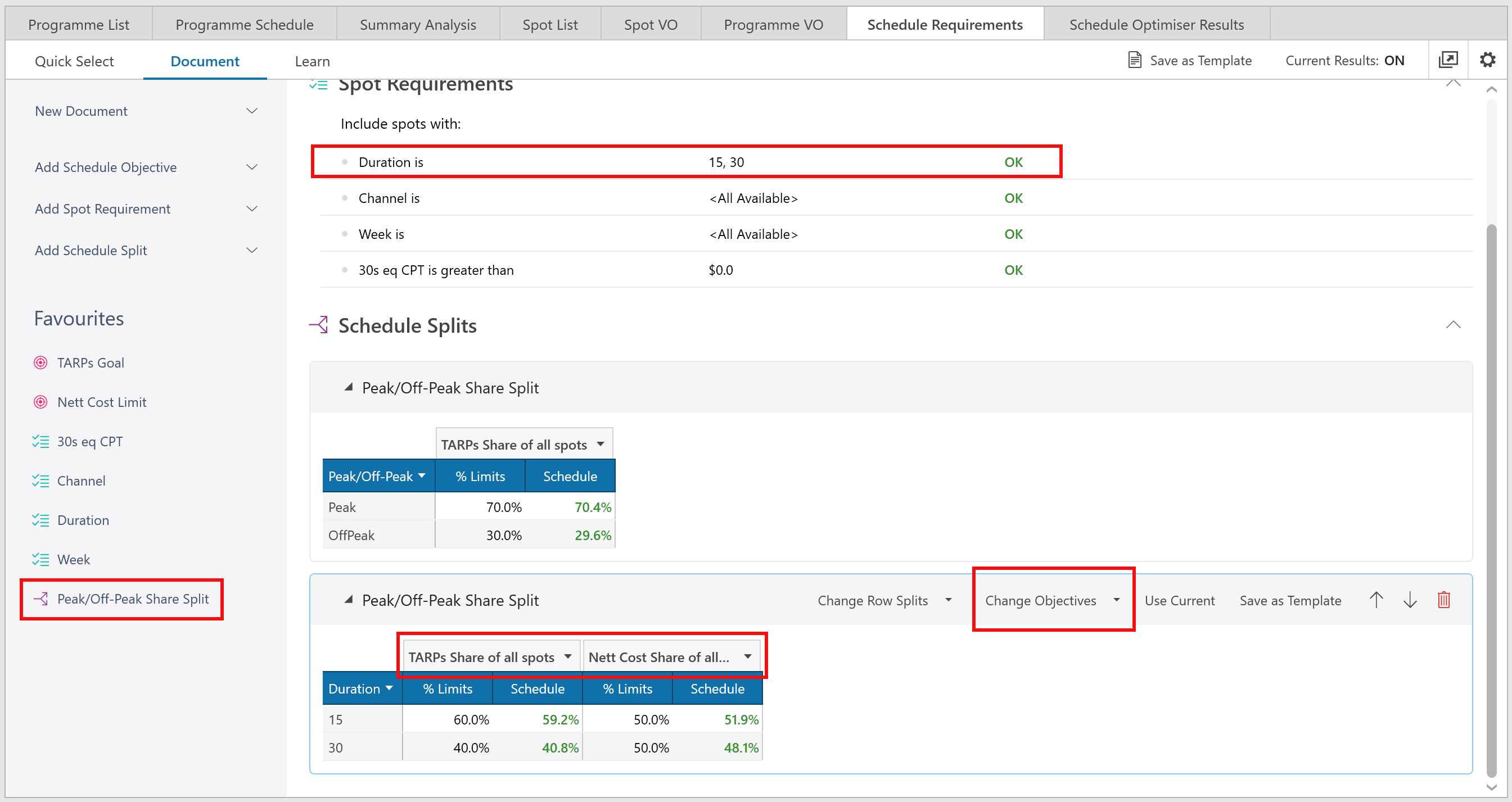
How can I resend spots to Warner Bros. Discovery or TVNZ?
In order to assist with creating Top-Up Buys, spots imported from a Campaign Manager or Pre/Post Analysis into buying will denote a booking status of Confirmed.
This means:
•New or top-up spots will display a booking status of New, spots already booked will display a booking status of Confirmed.
•Electronic Booking and Booking Forms will only display new spots. Confirmed spots are not resent to the Broadcaster to prevent double booking.

Should you need to resend spots to the Broadcaster we suggest you open your Buy then cut (CTRL-X) and paste (CTRL-V) all the spots into the Buy.
When doing this make sure you treat the spots as new bookings as well as choose the appropriate option for retaining cost/rating overrides.

How can I break down my R&F week by week?
Here is an example to explain how you can break down R&F week by week
Running a combined R&F
Consider the following buy where we have 1 spot booked over 4 weeks.
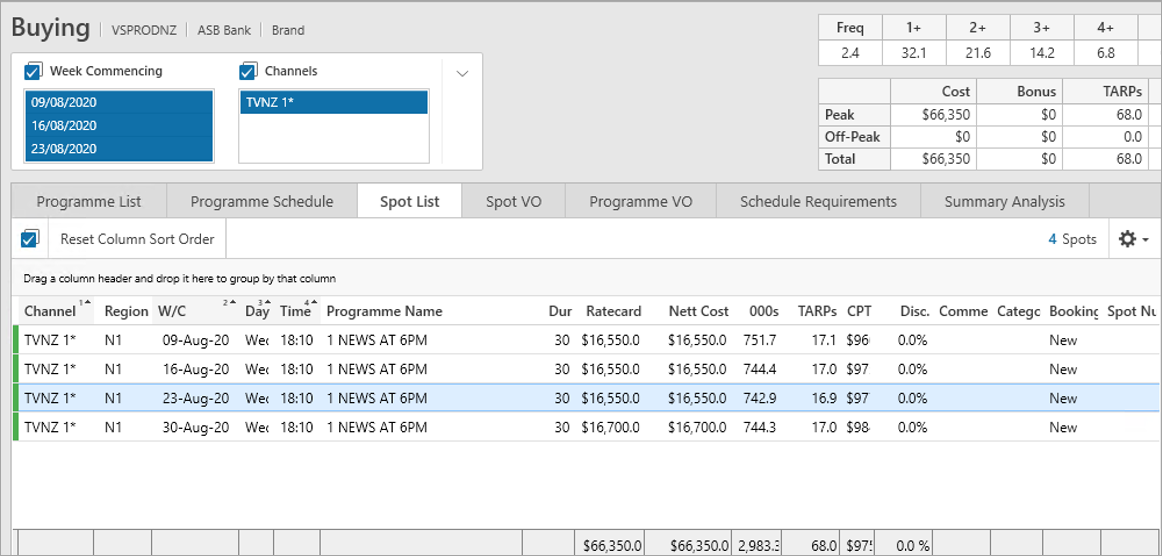
We now want to see the weekly build of reach in 000s.
If we run R&F for all the weeks and select 000s
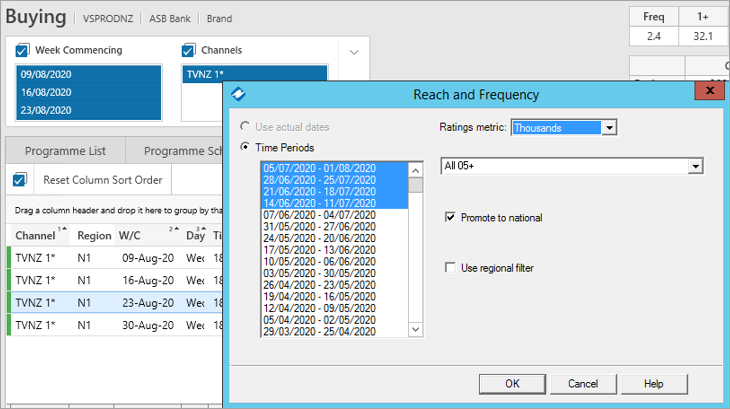
It will produce the R&F in 000s as below.

Each square represents the weekly spot fall, in this case its pretty simple as its only 1 spot played on TVNZ1 and TVNZ+1, but the same principle applies for schedules with more spots. If you find where the week ends this will show you the cume for the week.
In the first week the Cume is 848.8 (which is equal to the sum of the Rating or the sum of the 1+-10+ at the end of the week)
For the second week the ratings cume builds up to 1691.5 and the build in the 2nd week itself is the sum of the ratings in that week = 787.6+55.1 = 842.7 which is also the difference between the wk 1 and wk 2 cume. 1691.5-848.8=842.7.
Running R&F by Week
You can also see the weekly build by using the filter option in buying to run the R&F by week. Select the week you want to report on then run the R&F.
In this option I have chosen the first week.

Choose Yes to the option to use the filter.
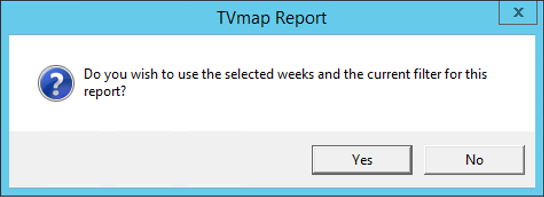
TVmap will select the appropriate weeks for the selected weeks. Note this will vary depending on the week you are running against. You should not adjust the weeks to try and match the combined weeks, otherwise your weekly R&F will be run in a different time period from the combined result. TVmap does this automatically for you.
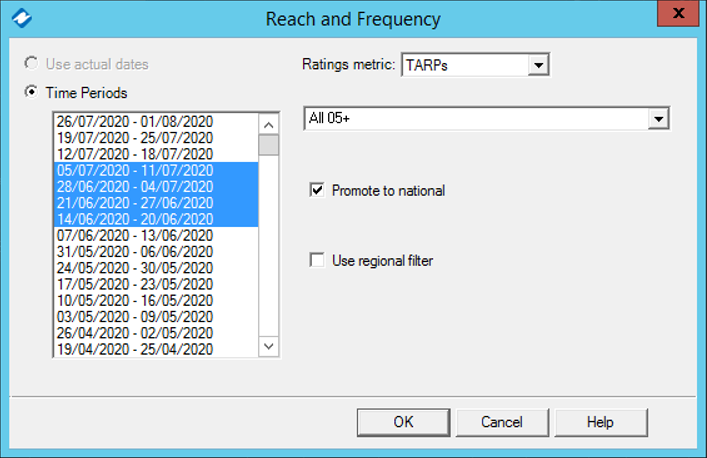
Here is the result for the first week R&F.

If you compare this with the first week of the combined R&F the Rating and Cume matches, but the 1+ - 10+ columns don’t. This is because when you only look at a single week, all the people are contributing to your 1+. If you consider the same spot but across all four weeks some of the people who saw the ad in the first week will see the advert in weeks 2-4, so the 1+ in the combined example is lower and the 2+ - 10+ values will be higher. (The rating/cume which is the combination of all the 1+ - 10+ will match).

Similarly, if you look at the performance for the 2nd week in the campaign using the filter option you get the following result.
Again, ratings match the combined values but the 1+ - 10+ will not match as the spots are only being considered in the context of a single week which affects the reach but not the rating. The Cume will be equal to the difference in cume between the end of the 1st week and the 2nd week in the combined report. (1691.5-848.5) = 843.
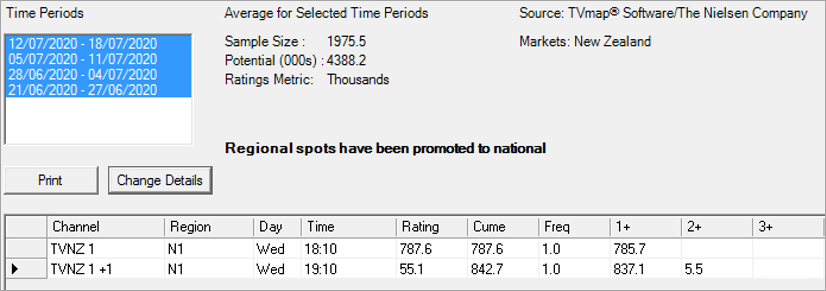

How do I analyse regional TARPs in Buying
If you are looking at booking a spot on a regional channel (say TVNZ1 Waikato) and wanting to see how this might rate. You would use the TVNZ1 Waikato channel and a demo with a regional filter on it.
If you are booking a spot on a national channel and wanted to know what impact it would have in a particular area (say Waikato) then you would use the national channel and a regional demo.
Freeview splits the country up into 3 parts so people in Waikato could see Auckland spots because they could be watching through Freeview this would account for differences between sales regions when analysing viewing.
R+F difference between regional and national figures:
You can see the difference between regional figures and national figures
3 factors in Buying:
1. $ you have to spend
2. Reach & Frequency you get
3. Target demo
If you want to buy in regional, and not promote to national. Please keep in mind that when running R&F for regional the sample size needs to be over 75. If not then it needs to be promoted to national.
•Run a R & F
•Don’t promote & national.
•Click on R & F
•Override visible ratings from R & F.
This will adjust the 1eTarps column (this will show in red). With a warning that seasonality does not apply.
To reset these, go back to the spot list and select all spots then right click and select Reset Ratings.
Using the regional Filter = same as using a regional demographic
What is the difference in demographic Sample and Potential sizes when running Reach & Frequency?
Demographic Sample & Potential sizes are indicative of historical period data as specified within the Source Week when you first enter your Buying Session details.
Sample & Potential sizes within R&F are dependent on the week selection criteria specified when running R&F.
If you select the same source weeks and same R&F weeks the sample and potential size is the same.
But as soon as you change the R&F week selection this adjusts your sample and potential against what they were from the source weeks to those weeks you selected when processing your R&F.
How do I modify the cost of a Programme?
Double click on the cost box in the spot detail pane.
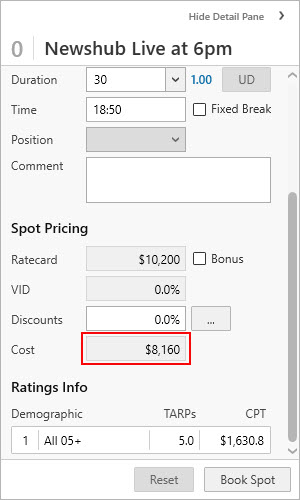
Then use one of the options under Modify Programme Nett Cost to change the cost.
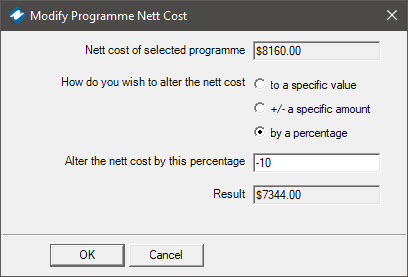
Or right click on the programme and under 'Modify Programmes' select Modify Cost.
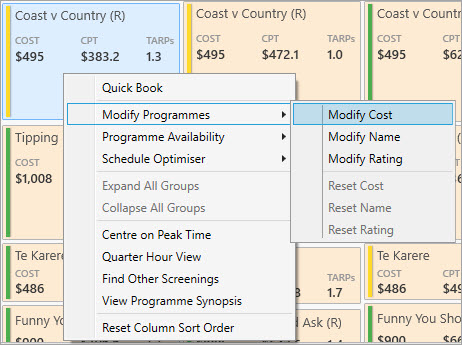
Which will also open the Modify Programme Nett Cost window.
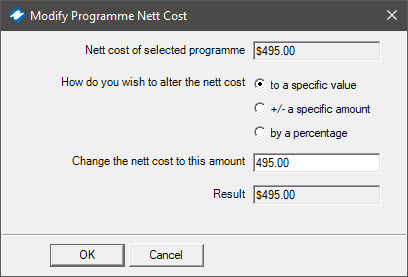
Click OK to save changes.
What can the middle mouse button be used for in TVmap?
•Quick book a spot in Programme List or Programme Schedule in Buying
Select a spot or multiselect spots and click middle mouse button or mouse wheel to quick book spots
•Close any tab
Hover over the tab and click the middle mouse button
•Open any saved or recent sessions tab in the background without navigating away from the current session
1.Hover over the buy you want to open in the background and click the middle mouse button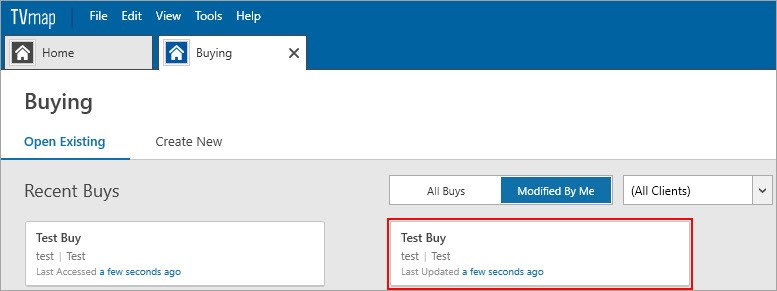
2.The Buy will then open in the background

3.Once open in the background, you can click on the tab to bring up the buy
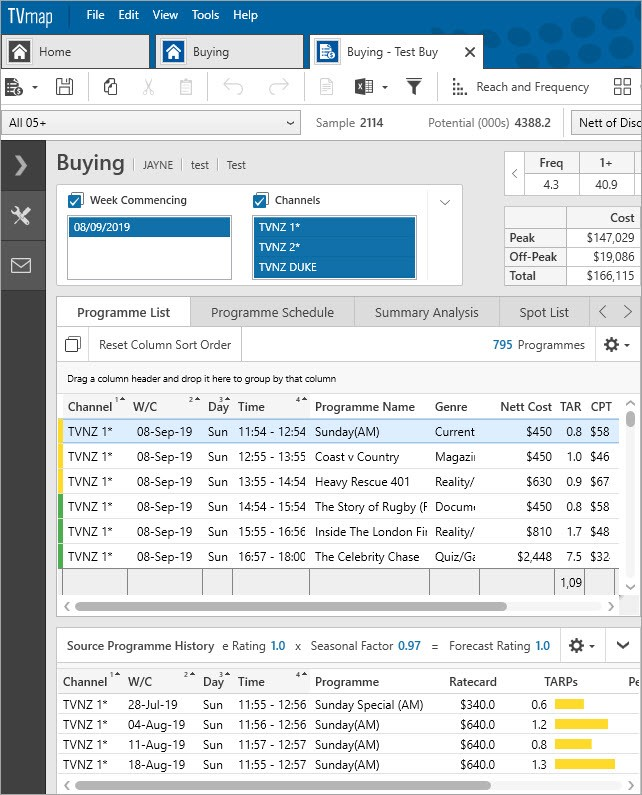
How to calculate incremental reach of a campaign using Buying
*The below example is calculating the incremental reach of a Newshub campaign for people who have watched 1 NEWS At 6pm
Book the Newshub spots
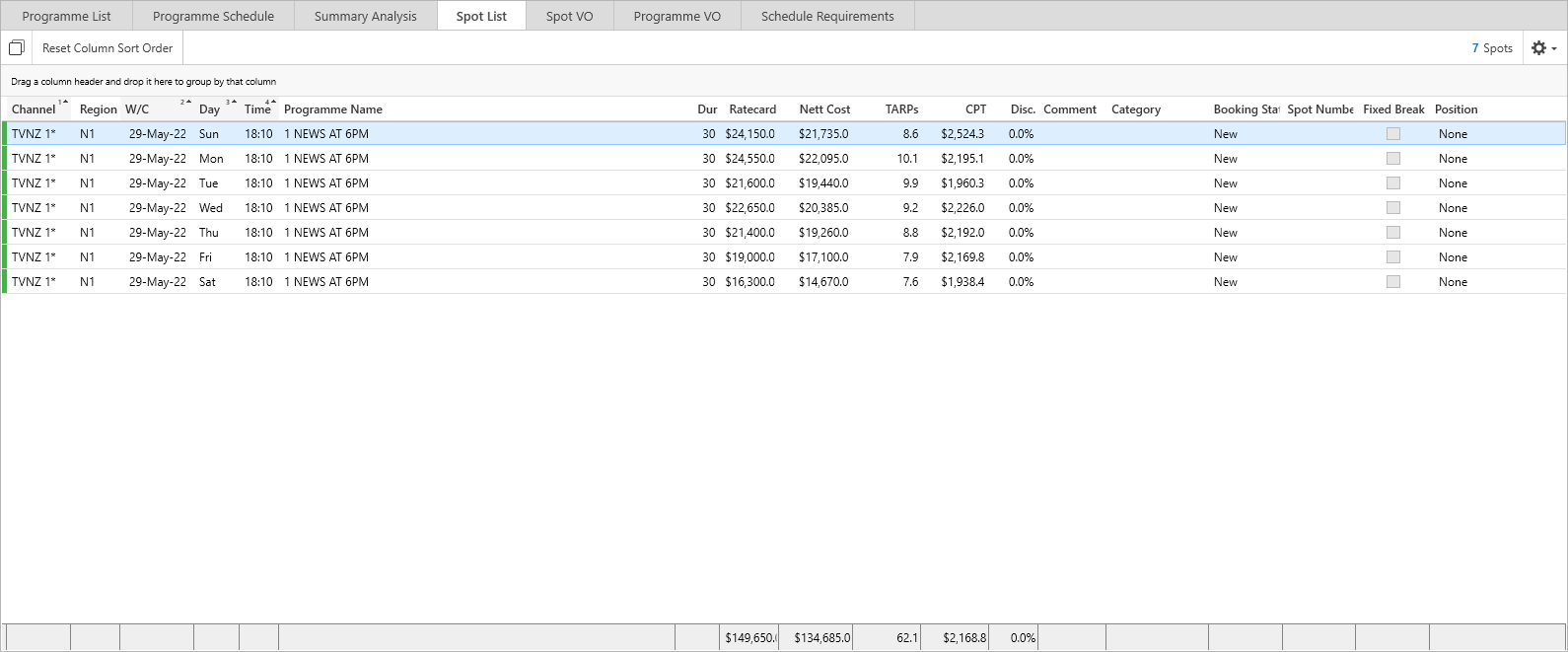
Go to Programme List and sort by Programme Name.
Right click and make all programmes unavailable, then select all 1 NEWS AT 6pm screenings and make them available.
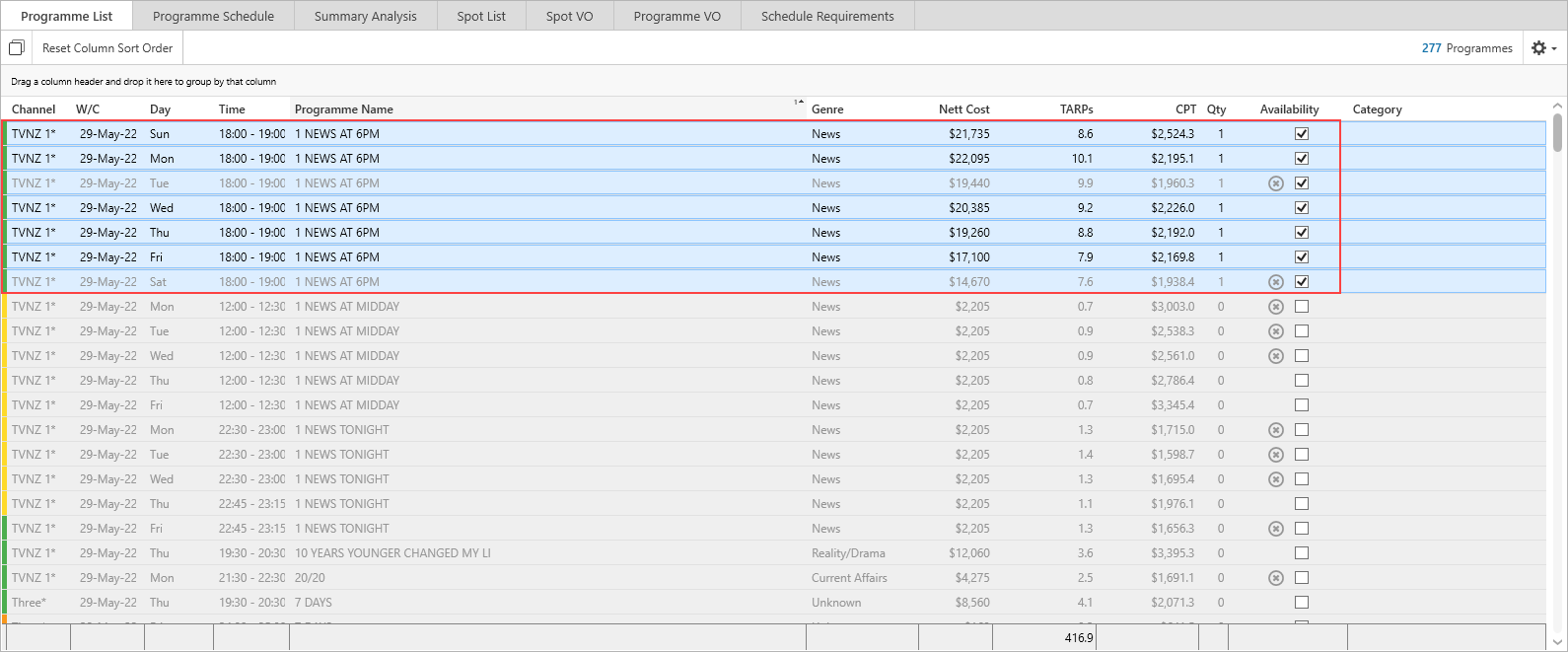
Apply a filter and check the option “Only user-defined available programmes”.
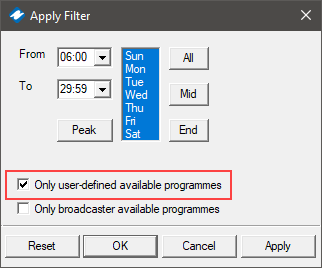
Go to Programme VO which will give the incremental reach for each 1 NEWS AT 6pm screening (in this example the reach goal has been set to 2+)
Based on the current 2+ of 14.4, 1 NEWS AT 6pm adds between 0.8 (15.2-14.4) and 2 (16.4-14.4) incremental reach.
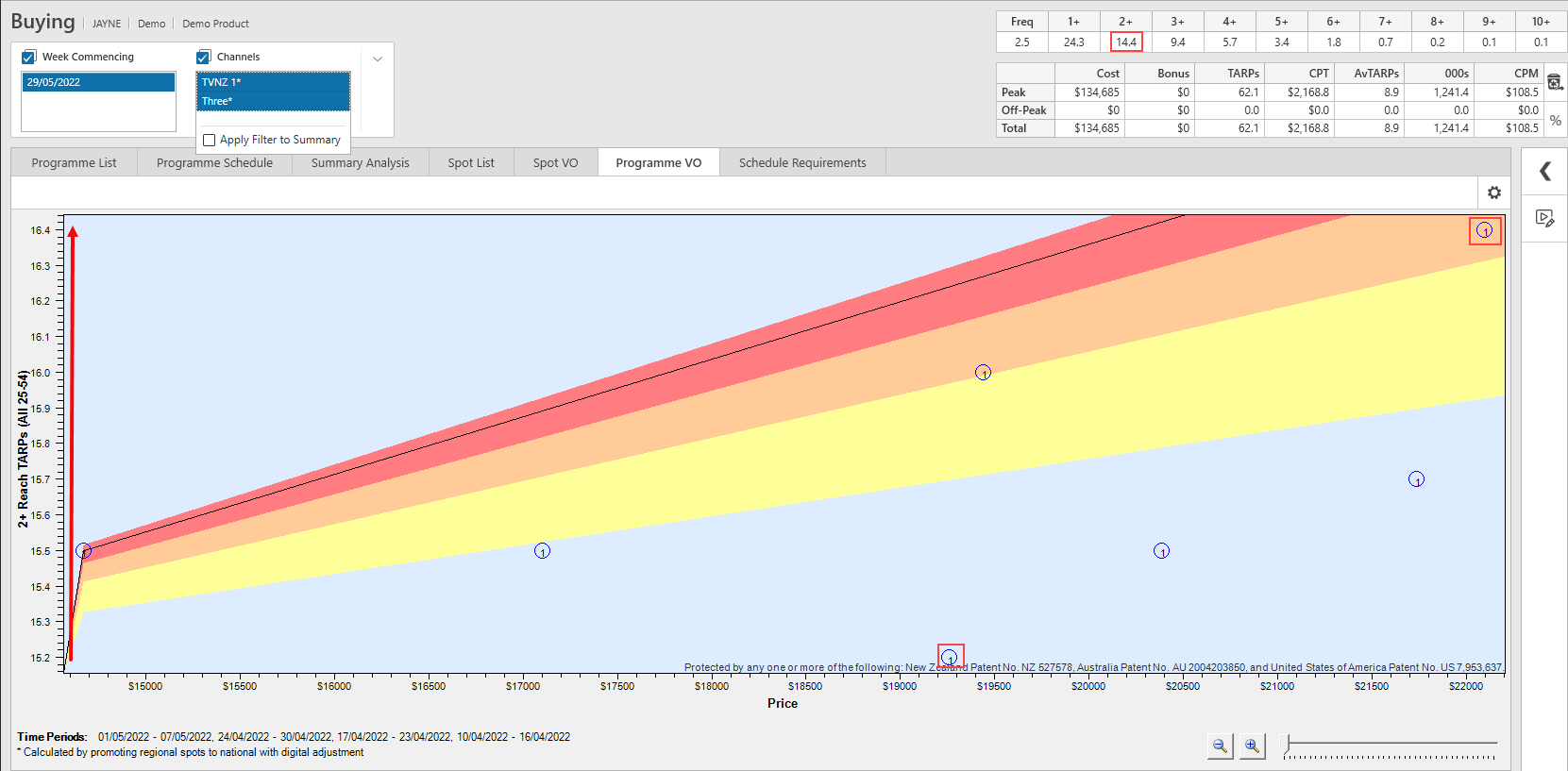
How to Index Two Separate Demographics Using Programme List
Select the two different demographics to index in Buying.
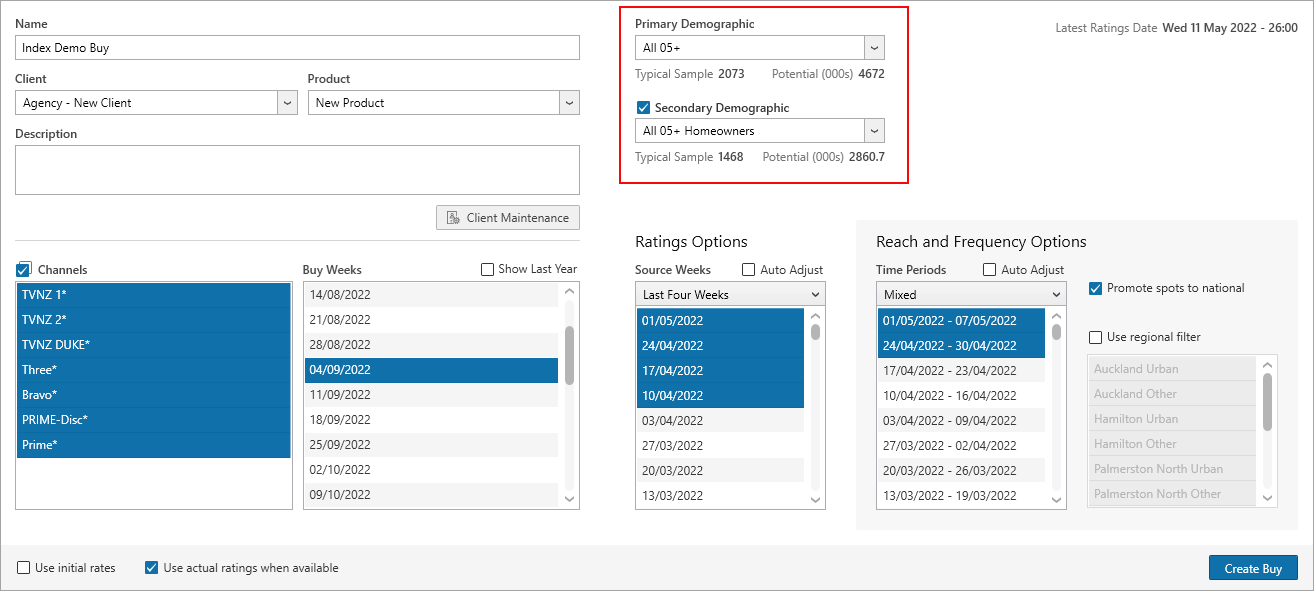
From the Programme List tab use the Export option to export the Programme List to Excel.
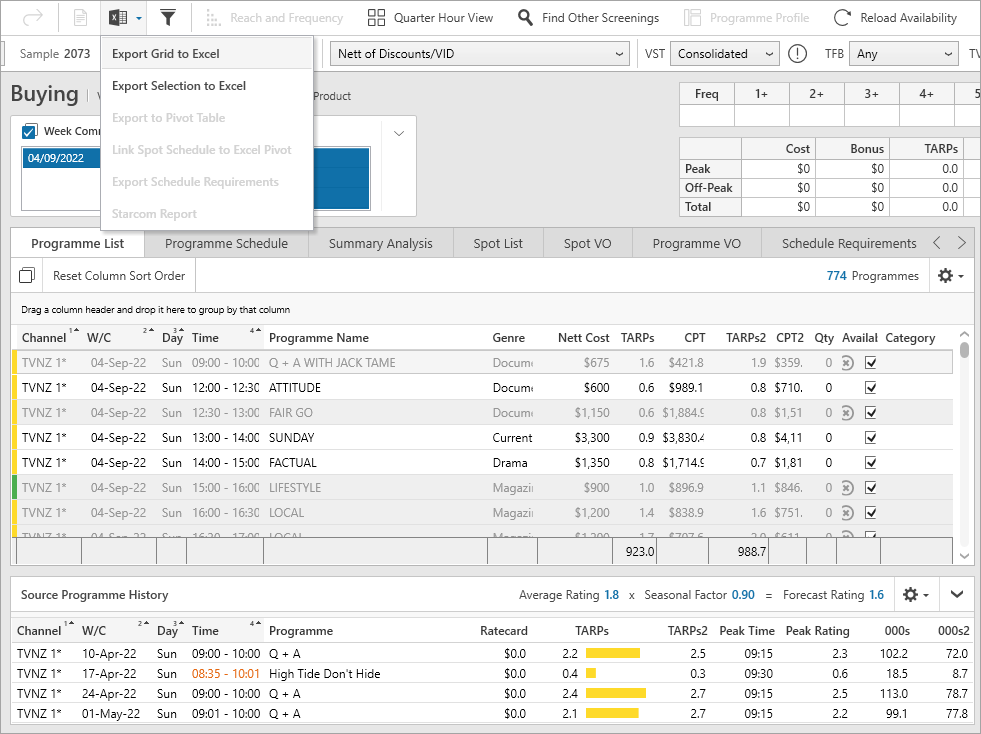
The primary demo is the TARPs column and the secondary demo is the TARPs2 column.
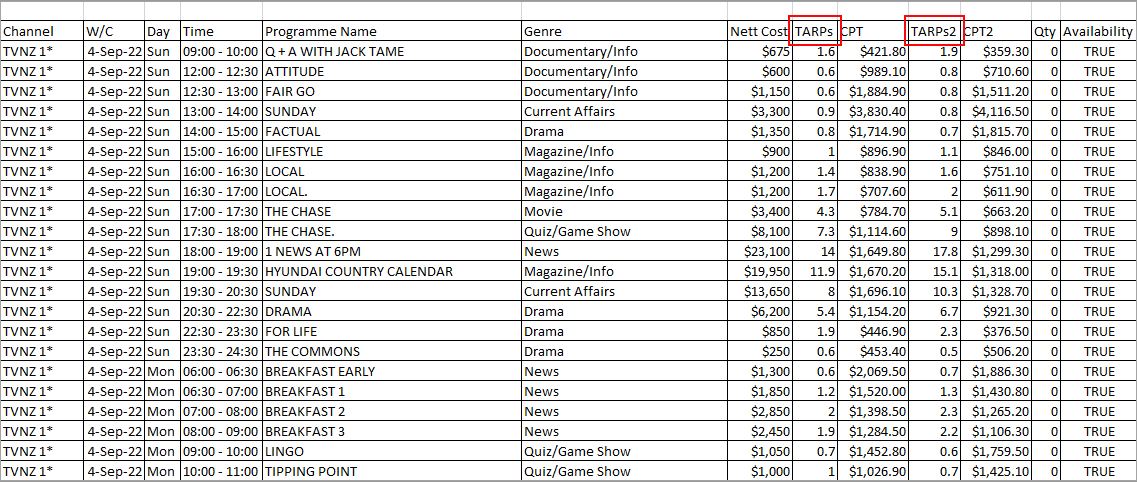
Can use this to calculate the index.
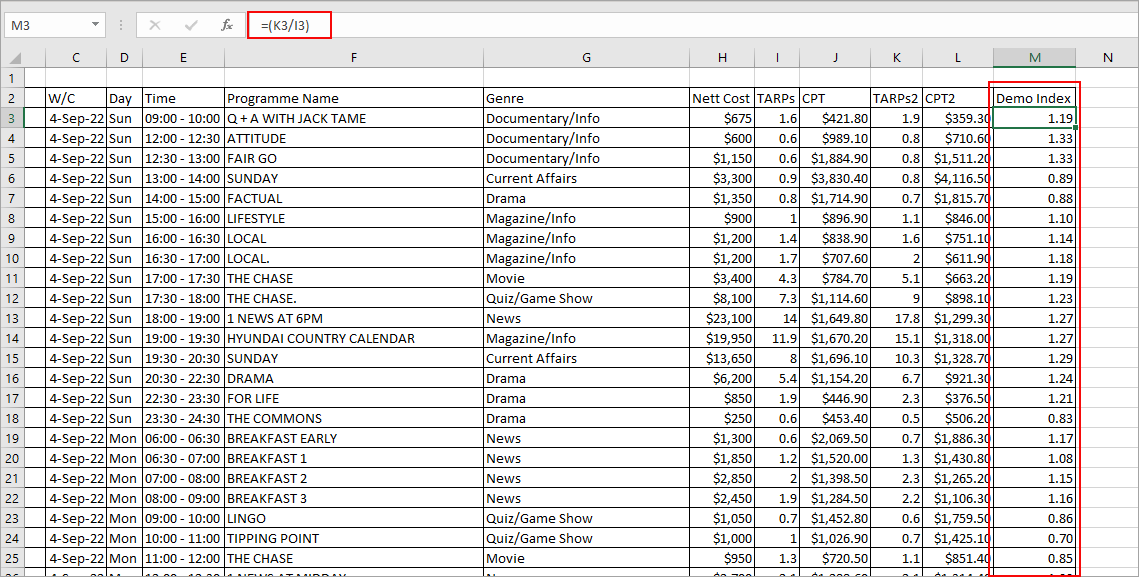
How can I see the 30sec Equivalent Ratings?
Click on the Export to Excel icon and from the drop down select Export to Pivot Table.
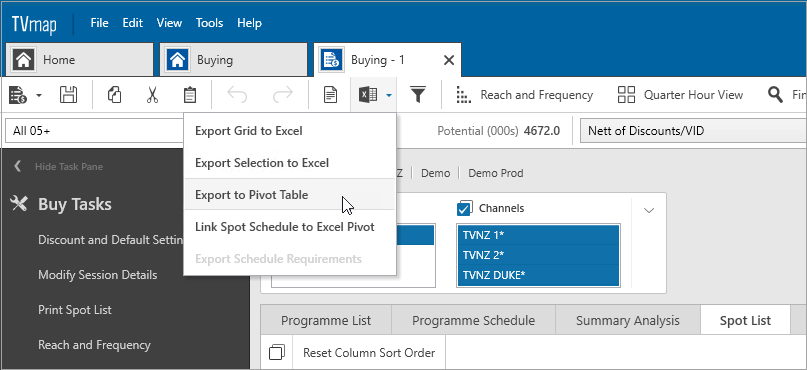
This will open an Excel workbook. Click on the Spots tab.

There will be a column called 30s Ratings which shows the 30sec equivalent rating.
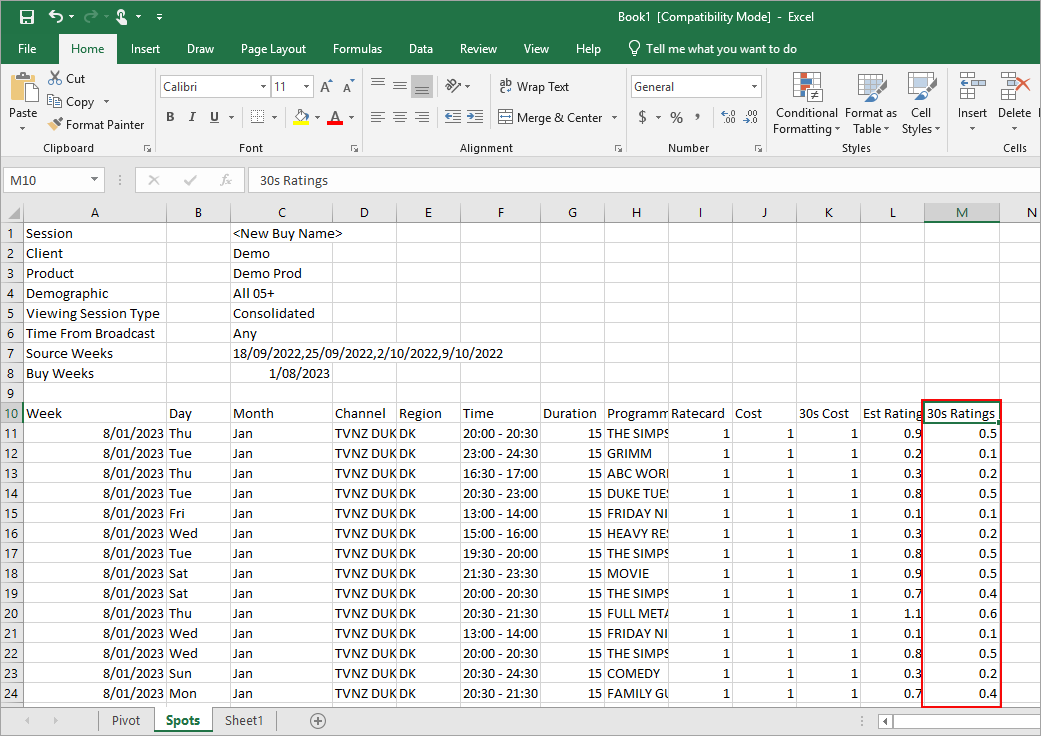
Why do the R&F 000s/TARPs differ from those in the Summary Box of Buying?
There are a couple of reasons why R&F 000s/TARPs are different from 000s/TARPs in the summary box for buys.
1. Buying does an average across the entire programme as the spot can potentially be placed anywhere in the programme.
R&F places the spot in an quarter hour, so will use the planned ¼ hr time of the spot (which is typically the best ¼ hr chosen by TVmap so tends to be higher).
2. Buying uses the ratings source weeks selected from the buy setup screen and does seasonal adjustment, R&F can use different source weeks but doesn’t seasonally adjust.
This can mean R&F will use different weeks from the buy ratings source weeks. Choosing the same weeks for R&F and the buy Source weeks will reduce the difference but it will still be different because of the programme average vs actual time used in R&F.
How can I quickly see what 1+ Reach I can achieve with a selected week and channel combination?
Create a buy with the selected weeks and channel.
Go to the Programme List and click in the top left corner to select all programmes.
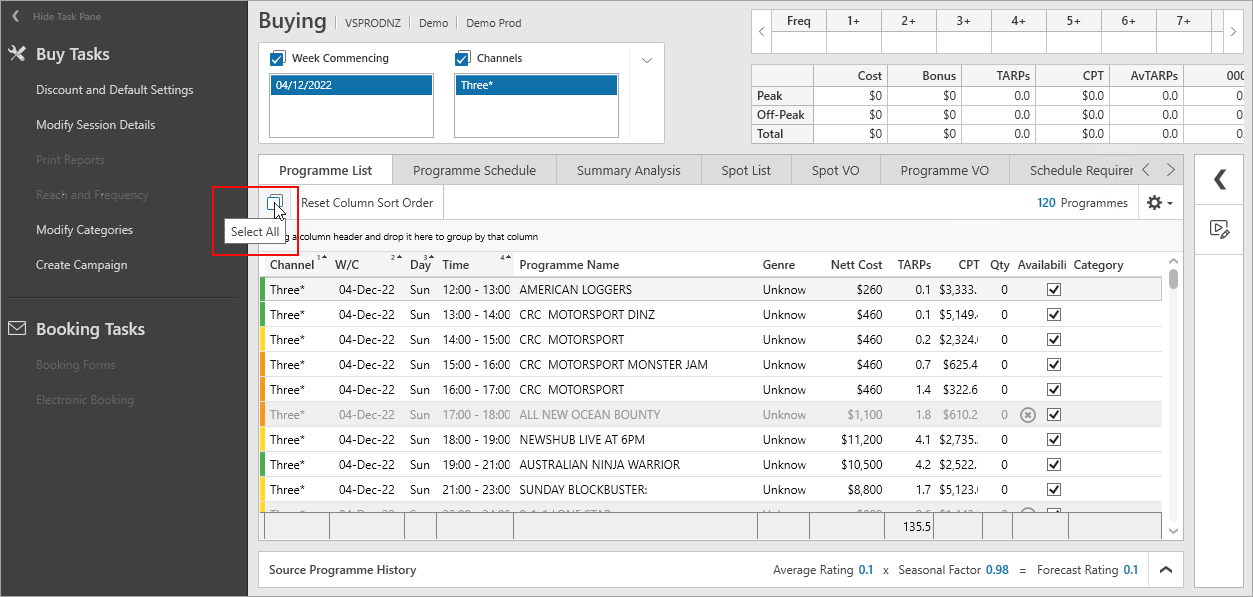
Right mouse click and select Quick Book to book a spot in every programme.
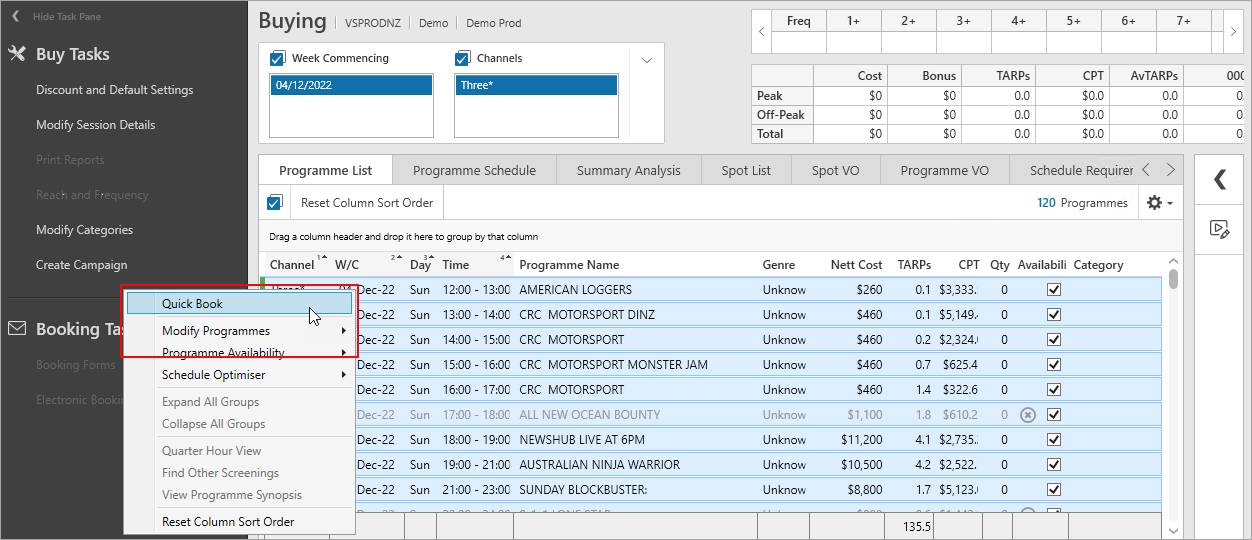
Reach performance will now populate and give you the maximum 1+ reach.
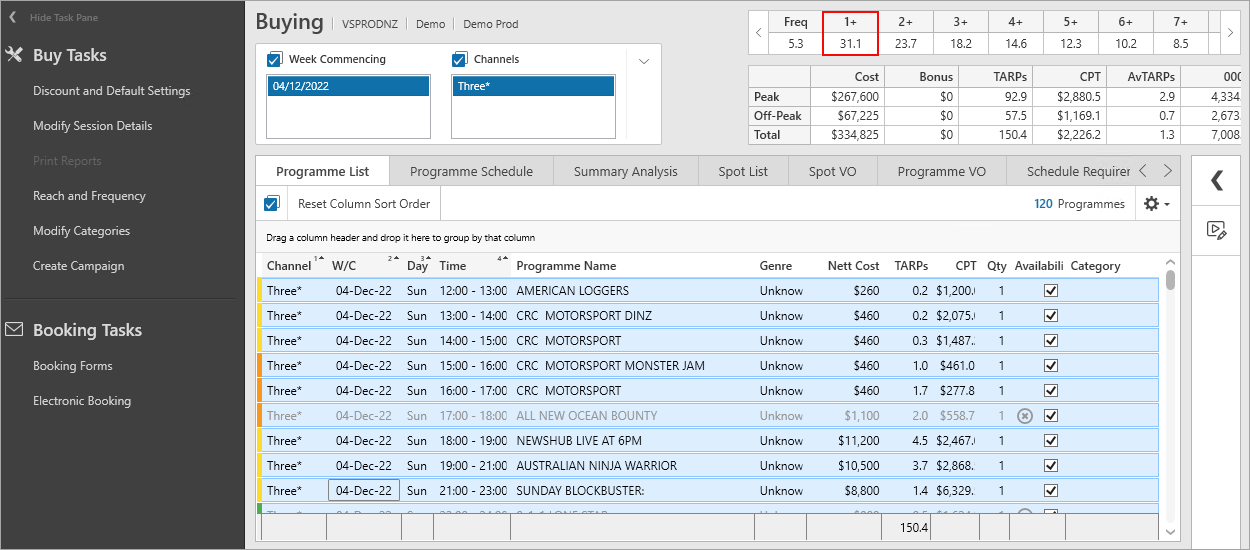
What's happening behind the scenes when users enter their Guaranteed Audience parameters?
The Guaranteed Audience engine runs multiple random booking scenarios to achieve the planned goals.
This is a randomised rather than an optimised approach to provide an indication of the Reach delivery for the TARP/000s goals.
Actual Reach may differ depending on how the broadcaster places spots within the campaign.
Why does the Buy Summary show a difference to the Guaranteed Audience line item(s)?
When Guaranteed Audience is being booked you may notice small differences between the GA line item and the Buy Summary as per the screen shot below.

The Guaranteed Audience line items are goals for the Guaranteed Audience Engine while the Buy Summary shows the total of spots booked.
Over/under booking can occur as the cost and TARP are both goals.
The engine will book spots to achieve both goals as closely as possible while generating different randomised options to provide an averaged result.
Provided the results are within 3% any scenario generated will be considered as having met the goals.
If Cost or TARP goals are not being met then adjusting one of the settings may allow both targets to be met if one of the goals is limiting options.
Have more questions? E-mail us: support@tvmap.com or call us: +64 9 304 0762
|
|
©2025 Broadcast M.A.P. Limited. All Rights Reserved.
|